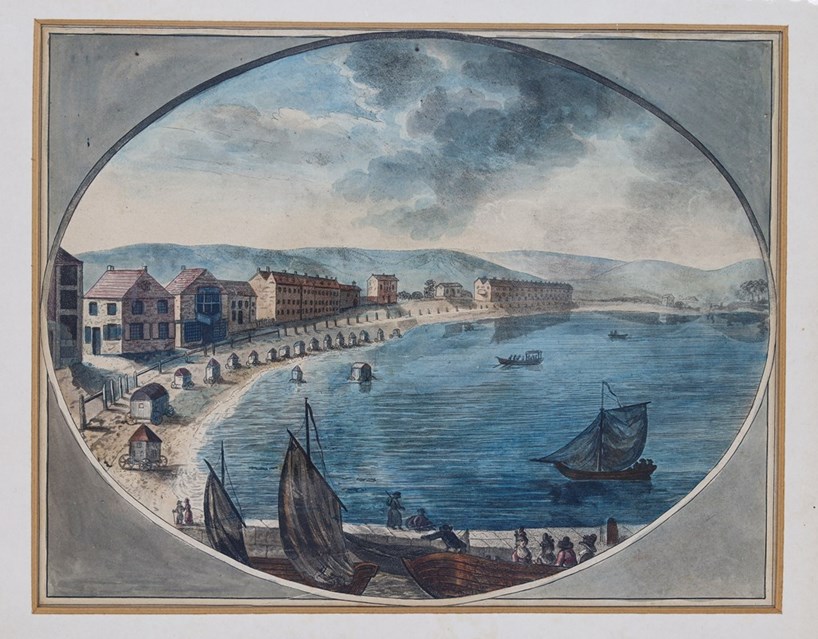DORCHESTER is so intrinsically linked to the writer and poet Thomas Hardy OM that it is a brave gallery director who has sought to find links for an exhibition of Jane Austen. It is a tribute to the focus of often smaller exhibitions in provincial museums that they can achieve more than might at first seem likely.
Here alongside postcards, paintings, and items of day-to-day life, the vivid designs made by students in costume and performance at Arts University Bournemouth provide ample opportunity for dressing up and joining the social set who went for a dip by day and retired to a circuit of balls in the evening.
There is a small watercolour from c.1770 of Weymouth Bay and Melcombe Regis. Looking closely, we see 16 bathing machines lined up along the shoreline beyond the quayside in the foreground. Two of the bathing machines have already been taken out into the water.
Sea bathing had, as this delightful watercolour shows, already been well established, but it is only when King George III began to visit Weymouth and stay at Gloucester Lodge regularly from 1789 until 1805, but others, in pursuit of celebrity and monarchy, joined in the craze.
 © Dorset Museum & Art GalleryWeymouth Bay and Melcombe Regis (c.1770), artist unknown
© Dorset Museum & Art GalleryWeymouth Bay and Melcombe Regis (c.1770), artist unknown
From school at Southampton, Jane Austen knew the coast well, and her first holidays at Lyme Regis were in 1804. From her letters, we know that she enjoyed longer visits to Sidmouth, Worthing, and south Wales, as well as the coasts of Kent and Sussex. Her last novel, Persuasion, in part is set at Lyme Regis and her last unfinished project (she died on 18 July 1817). Sanditon is set in a coastal town in Sussex.
Jane Austen, the 250th anniversary of whose birth is being celebrated widely, was born to privilege in a Hampshire rectory on 16 December 1775 and was baptised there the next day. Both her father and her maternal grandfather were clergymen in the Church of England, and one of her brothers later took Orders after a career in banking. Two of her other brothers, Frank and Charles, served in the Navy, rising to become Admirals. No ordinary family, but, rather, one with leisure and opportunity deriving from inherited monies in a society gently pilloried in Austen’s novels.
The Sea City Museum in Southampton is hosting an exhibition, “A Very Respectable Company: Jane Austen and her Southampton Circle” (until 31 October); and the Arc, Winchester, is hosting a more mundane show, “Beyond the Bonnets”, exploring working women in her novels (until 2 November). At Harewood House, in Yorkshire, “Austen and Turner: A Country House Encounter” (until 9 October) celebrates the author with the painter J. M. W. Turner, who was also born in 1775.
At Dorchester, we get to see guide books of the period which begin to promote the coast, as well as first editions of both Northanger Abbey and Persuasion on loan from her house museum at Chawton. As a picture of Regency England, the exhibition serves well to remind us how, in a pre-industrial era, life revolved around the church while offering (some) the chance to lead lives refreshed by jollity.
“Jane Austen: Down to the Sea” is in the Dorset Museum and Art Gallery, High Street, Dorchester, Dorset, until 14 September. Phone 01305 262735. www.dorsetmuseum.org















